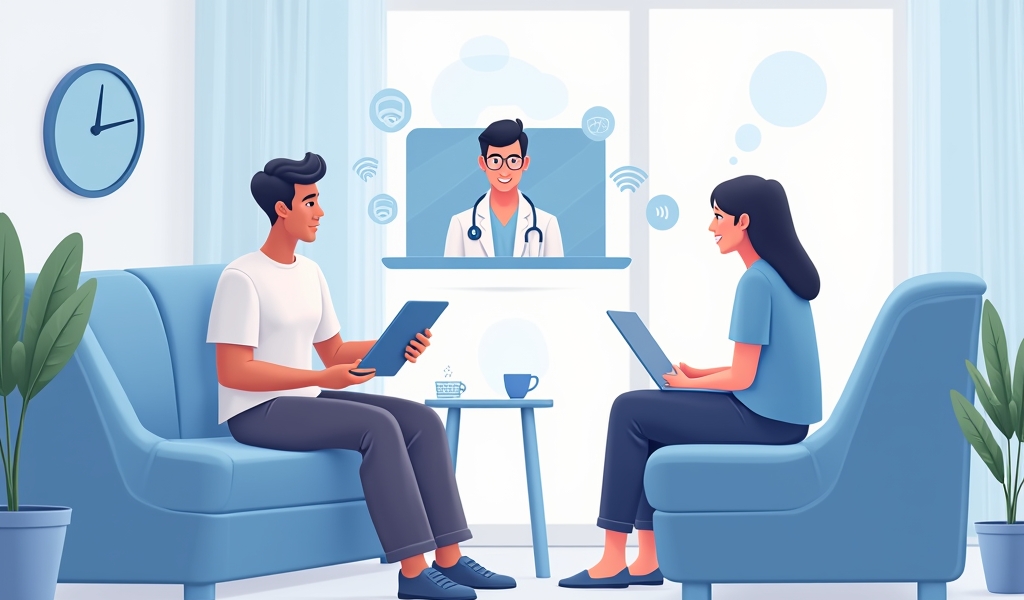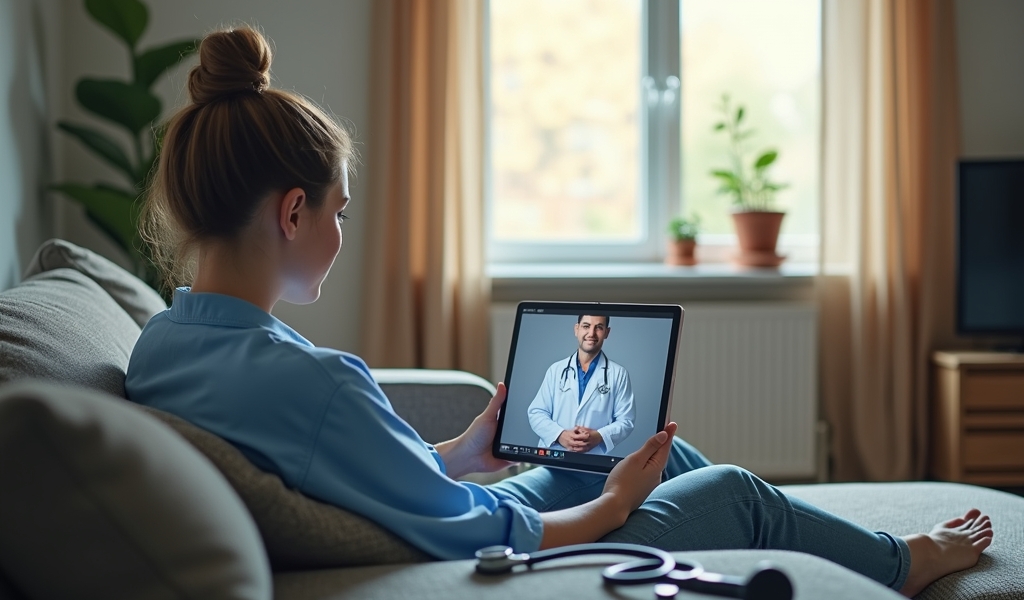Overview
Virtual doctor visits offer five major benefits: unmatched convenience and accessibility, reduced exposure to illness, significant time and cost savings, expanded access to specialists regardless of location, and improved continuity of care for chronic conditions. These telehealth services have transformed from an alternative option to a mainstream healthcare solution, effectively treating common conditions while saving patients an average of 100 minutes per appointment compared to traditional in-person visits.
Table of Contents
- Benefit #1: Unmatched Convenience and Accessibility
- Benefit #2: Reduced Exposure to Illness
- Benefit #3: Time and Cost Savings
- Benefit #4: Expanded Access to Specialists
- Benefit #5: Continuity of Care and Follow-ups
- When Virtual Visits Work Best
- How to Find “Virtual Doctor Visits Near Me”
- The Future of Healthcare is Virtual
- Frequently Asked Questions
In recent years, the healthcare landscape has undergone a remarkable transformation with the rise of telehealth services. What was once considered an alternative form of medical care has now become a mainstream option for millions of Americans seeking convenient healthcare solutions. The phrase “virtual doctor visit near me” has quickly become one of the most searched healthcare terms, especially since the COVID-19 pandemic accelerated the adoption of remote medical services.
At Dr. Telx, we’ve witnessed firsthand how telehealth is revolutionizing access to quality healthcare. Today, we’re sharing the five most significant benefits that make virtual doctor visits an increasingly popular choice for patients of all ages and backgrounds. Whether you’re managing a chronic condition, seeking urgent care, or simply due for a check-up, understanding these advantages can help you make informed decisions about incorporating telehealth into your healthcare routine.
Benefit #1: Unmatched Convenience and Accessibility
Perhaps the most obvious benefit of virtual doctor visits is the remarkable convenience they offer. Gone are the days of fighting traffic, searching for parking, or sitting in crowded waiting rooms for hours on end. With telehealth services, quality medical care is literally at your fingertips.
Virtual appointments eliminate transportation barriers entirely, making healthcare accessible to everyone with an internet connection. This accessibility is particularly valuable for:
- Patients with mobility challenges or disabilities
- Individuals living in rural areas far from medical facilities
- Parents who would otherwise need childcare to attend appointments
- Busy professionals who struggle to fit healthcare into packed schedules
- Elderly patients who rely on others for transportation
A recent study found that telehealth appointments save patients an average of 100 minutes compared to in-person visits when accounting for travel and waiting room time. That’s valuable time you can spend on work, family, or self-care instead.
Benefit #2: Reduced Exposure to Illness
One benefit that became especially apparent during the pandemic is how virtual visits minimize exposure to contagious illnesses. Traditional medical settings, despite best efforts, can be breeding grounds for germs. Telehealth eliminates this risk entirely by allowing you to consult with healthcare providers from the safety of your home.
This advantage is particularly significant for:
- Immunocompromised patients at higher risk of complications
- Elderly individuals more susceptible to serious infections
- People with chronic conditions that could be exacerbated by additional illnesses
- Parents with young children who touch everything in sight
- Anyone during peak flu season or amid other disease outbreaks
By choosing virtual care when appropriate, you’re not just protecting yourself but also helping to reduce community spread of contagious conditions – a benefit to public health at large.

Benefit #3: Time and Cost Savings
Virtual doctor visits aren’t just convenient; they’re often more economical as well. The financial benefits extend beyond the obvious elimination of transportation costs like gas, parking fees, or public transit fares.
Consider these additional savings:
- Lower co-pays, as many insurance companies offer reduced rates for telehealth visits
- Reduced or eliminated need for childcare during appointments
- Less time away from work, potentially saving paid time off or wages
- No spending on meals or snacks while away from home
- Reduced exposure to impulse shopping that might occur with in-person visits
Many patients report saving between $25 and $75 per telehealth visit when accounting for these factors. Over time, these savings can add up substantially, especially for those managing chronic conditions requiring frequent check-ins.
Benefit #4: Expanded Access to Specialists
Finding specialists can be challenging, particularly for those living outside major metropolitan areas. Virtual care breaks down these geographical barriers, connecting patients with specialists regardless of location.
Through telehealth platforms like Dr. Telx, patients can:
- Consult with highly specialized physicians who may not practice locally
- Get appointments with specialists significantly faster than waiting for in-person visits
- Easily obtain second opinions from experts across the country
- Maintain relationships with trusted specialists even after relocating
- Access specialized care without the need for lengthy travel
This democratization of specialized healthcare means that your zip code no longer determines the quality of care you can receive. A patient in rural Wisconsin can now access the same caliber of specialist as someone living next door to a major medical center in Boston.

Benefit #5: Continuity of Care and Follow-ups
Maintaining consistent healthcare is crucial for managing chronic conditions and preventing new health issues. Virtual visits make continuity of care simpler and more accessible than ever before.
Telehealth excels at facilitating:
- Regular check-ins that might otherwise be missed due to scheduling difficulties
- Quick follow-up appointments to discuss test results or treatment effectiveness
- Ongoing monitoring of chronic conditions like diabetes or hypertension
- Seamless medication management and prescription refills
- Consistent mental health support through regular therapy sessions
Studies show that patients who utilize telehealth for follow-up care maintain better medication adherence and experience fewer hospital readmissions. This improved continuity translates directly to better health outcomes and quality of life.
When Virtual Visits Work Best
While telehealth offers numerous benefits, it’s important to understand when virtual care is most appropriate. Telehealth is particularly effective for:
- Common acute conditions like colds, flu, allergies, and minor infections
- Ongoing management of chronic conditions like diabetes, hypertension, and asthma
- Mental health services including therapy and medication management
- Dermatological issues that can be visually assessed
- Prescription refills and medication consultations
- Post-surgical follow-ups that don’t require physical examination
Of course, some situations still warrant in-person care, including medical emergencies, conditions requiring physical examination or procedures, and initial diagnostics for complex conditions. When in doubt, a brief virtual doctor appointment can help determine if an in-person visit is necessary.
How to Find “Virtual Doctor Visits Near Me”
Finding quality telehealth services is easier than ever. Here are the best ways to locate virtual care options:
- Check with your insurance provider: Many insurance companies have preferred telehealth partners with reduced co-pays.
- Contact your current healthcare system: Most hospital networks and primary care practices now offer virtual visits.
- Explore dedicated telehealth platforms: Services like Dr. Telx provide comprehensive virtual care with experienced providers.
- Ask about integration: Look for telehealth providers that can coordinate with your existing healthcare team and share medical records seamlessly.
When evaluating telehealth options, consider factors like provider credentials, available specialties, appointment availability, technical requirements, and cost structure.
The Future of Healthcare is Virtual
The five benefits we’ve explored – convenience, reduced illness exposure, cost savings, specialist access, and care continuity – represent just the beginning of telehealth’s potential. As technology continues to advance, we can expect even more sophisticated remote monitoring, AI-assisted diagnostics, and seamless integration with in-person care.
At Dr. Telx, we’re committed to being at the forefront of this healthcare revolution, providing accessible, high-quality online doctor visit options for conditions ranging from urgent needs to chronic disease management.
Ready to experience the benefits of telehealth for yourself? Explore our virtual primary care, urgent care consultations, prescription management, and specialized services today. Quality healthcare is no longer bound by location – it’s available wherever and whenever you need it.
According to the CDC’s National Center for Health Statistics, the percentage of adults who had used telemedicine in the past 12 months increased from 19.5% in 2019 to 37.0% in 2021, demonstrating the rapid adoption of virtual healthcare solutions.
Your health journey deserves the convenience, accessibility, and quality that virtual doctor visits provide. The future of healthcare is here – and it fits perfectly into your busy life.
Frequently Asked Questions
What conditions can be treated through a virtual doctor visit near me?
Virtual doctor visits can effectively address a wide range of conditions, including cold and flu symptoms, allergies, rashes, minor infections, medication management, mental health concerns, and chronic condition management like diabetes or hypertension. However, emergency situations, conditions requiring hands-on physical examination, or those needing immediate diagnostic tests are better suited for in-person care. When in doubt, start with a virtual visit, and the provider can direct you to in-person care if necessary.
Are virtual doctor visits covered by insurance?
Yes, most major insurance providers now cover virtual doctor visits, though coverage varies by plan. Since the COVID-19 pandemic, insurance companies have significantly expanded telehealth coverage, with many offering the same coverage as in-person visits. Some even provide lower copays for telehealth to encourage its use. Always verify coverage with your specific insurance provider before scheduling an appointment. Many telehealth platforms can check your benefits for you during the scheduling process.
How do I prepare for a virtual doctor visit?
To get the most from your virtual doctor visit, prepare by: 1) Testing your technology (camera, microphone, internet) before the appointment; 2) Finding a quiet, well-lit private space for the call; 3) Writing down your symptoms, concerns, and questions beforehand; 4) Having your current medications list ready; 5) Taking relevant readings if possible (temperature, blood pressure, weight); and 6) Wearing clothing that allows you to show affected areas if needed. It’s also helpful to have your pharmacy information available for any prescriptions that might be needed.
How secure are virtual doctor visits?
Reputable telehealth providers use HIPAA-compliant platforms with end-to-end encryption to ensure patient privacy and data security. These platforms are specifically designed for healthcare and offer significantly more protection than general video chat applications. Additionally, healthcare providers are bound by the same privacy laws and ethical guidelines during virtual visits as they are during in-person appointments. If you have concerns, ask your provider about their specific security measures and data protection policies.
Can I get prescriptions through a virtual doctor visit?
Yes, doctors can prescribe many medications during virtual visits, including antibiotics, blood pressure medications, antidepressants, and various other prescription medications. The prescription is typically sent electronically to your preferred pharmacy. However, there are limitations – controlled substances like narcotics and certain anxiety medications may have restrictions depending on state laws and federal regulations. Some medications might require in-person evaluations before prescription or renewal, particularly if they require physical monitoring or testing.

